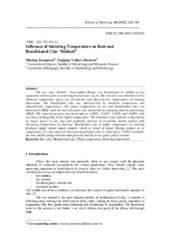Приказ основних података о документу
Influence of sintering temperature on raw and beneficiated clay 'Klokoti'
| dc.creator | Jovanović, Marina | |
| dc.creator | Volkov-Husović, Tatjana | |
| dc.date.accessioned | 2021-03-10T11:45:12Z | |
| dc.date.available | 2021-03-10T11:45:12Z | |
| dc.date.issued | 2012 | |
| dc.identifier.issn | 0350-820X | |
| dc.identifier.uri | http://TechnoRep.tmf.bg.ac.rs/handle/123456789/2046 | |
| dc.description.abstract | The raw clay 'Klokoti' from middle Bosnia was beneficiated by method of wet separation which results in removing fraction over 20 μm. The raw clay was characterized by chemical composition, grain size distribution and characteristic temperatures on heating microscope. The beneficiated clay was characterized by chemical composition and characteristic temperatures. The phase composition of raw and beneficiated clay was observed by RDA while the microstructure was monitored on scanning electron microscope (SEM). The sintering process was performed at 1100ºC, 1250ºC, 1320ºC and 1400ºC with two hours holding time at the highest temperature. The obtained results indicate a big content of coarse quartz in raw clay and gradually increase of crystalline mullite content with increasing temperature of sintering. Beneficiated clay at higher temperature of sintering produces larger glassy phase content, which is result of larger fluxing content in its composition. It is also observed that from beneficiated clay by sintering at 1250°C crystallize the most mullite along with minimum porosity and the lowest glassy phase content. | en |
| dc.description.abstract | Sirova glina 'Klokoti' iz srednje Bosne je oplemenjena metodom mokre separacije, čime je uklonjena frakcija ispod 20 μm. Karakterizacija sirove gline je vršena preko hemijskog i granulometrijckog sastava, i karakterističnih temperatura korišćenjem zagrevnog mikroskopa. Oplemenjena glina je karakterisana preko hemijskog sastava i karakterističnih temperatura. Fazni sastav sirove i oplemenjene gline je određen preko RDA, dok je mikrostruktura određena korišćenjem skening elektronskog mikroskopa (SEM). Proces sinterovanja je se odvijao na 1100º, 1250º, 1320º i 1400ºC u trajanju od dva časa zadržavanja na najvišoj temperaturi. Dobijeni rezultati ukazuju na visok sadržaj krupno zrnastog kvarca u sirovoj glini i postepeno povećanje kristalnog mulita sa povišenjem temperature sinterovanja. Kod oplemenjene gline, na višim tempetarurama sinterovanja, stvara se veća količina staklaste faze, što je posledica većeg udela topitelja u njenom sastavu. Takođe je uočeno da iz te gline, pri sinterovanju na 1250°C, kristališe najviše mulita uz najnižu poroznost i najmanju količinu staklaste faze. | sr |
| dc.publisher | International Institute for the Science of Sintering, Beograd | |
| dc.relation | Ministry of Education and Science of Federation of Bosnia and Herzegovina | |
| dc.relation | info:eu-repo/grantAgreement/MESTD/Integrated and Interdisciplinary Research (IIR or III)/45012/RS// | |
| dc.rights | openAccess | |
| dc.rights.uri | https://creativecommons.org/licenses/by/4.0/ | |
| dc.source | Science of Sintering | |
| dc.subject | raw clay | en |
| dc.subject | beneficiated clay | en |
| dc.subject | phase composition | en |
| dc.subject | sintering temperature | en |
| dc.subject | sirova glina | sr |
| dc.subject | oplemenjena glina | sr |
| dc.subject | fazni sastav | sr |
| dc.subject | temperature sinterovanja | sr |
| dc.title | Influence of sintering temperature on raw and beneficiated clay 'Klokoti' | en |
| dc.type | article | |
| dc.rights.license | BY | |
| dc.citation.epage | 168 | |
| dc.citation.issue | 2 | |
| dc.citation.other | 44(2): 161-168 | |
| dc.citation.rank | M23 | |
| dc.citation.spage | 161 | |
| dc.citation.volume | 44 | |
| dc.identifier.fulltext | http://TechnoRep.tmf.bg.ac.rs/bitstream/id/11981/0350-820X1202161J.pdf | |
| dc.identifier.rcub | https://hdl.handle.net/21.15107/rcub_technorep_2046 | |
| dc.identifier.scopus | 2-s2.0-84866356628 | |
| dc.identifier.wos | 000318148600004 | |
| dc.type.version | publishedVersion |

